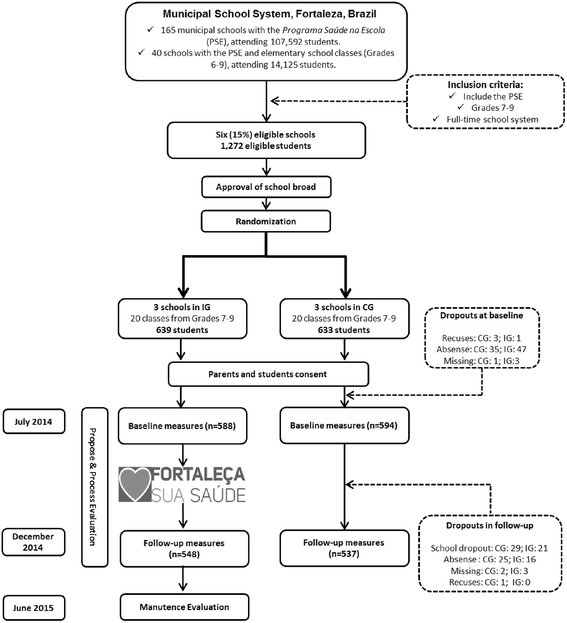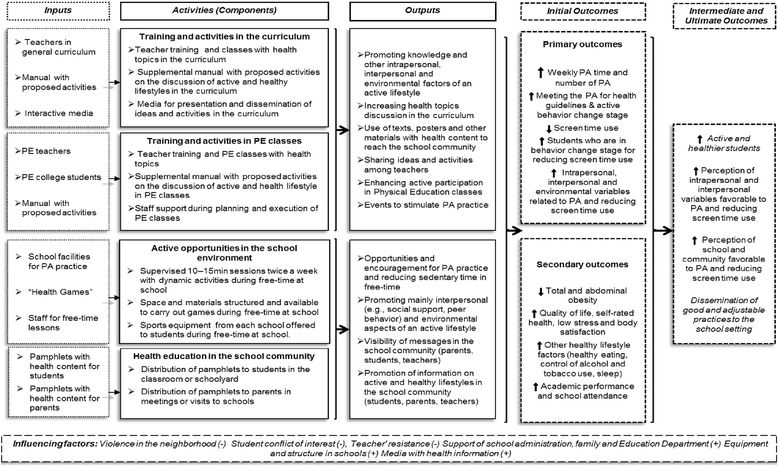Rationale and methods of a cluster-randomized controlled trial to promote active and healthy lifestyles among Brazilian students: the "Fortaleça sua Saúde" program
- PMID: 26643919
- PMCID: PMC4671221
- DOI: 10.1186/s12889-015-2543-2
Rationale and methods of a cluster-randomized controlled trial to promote active and healthy lifestyles among Brazilian students: the "Fortaleça sua Saúde" program
Abstract
Background: Interventions on adolescents' lifestyle are important, but the main mechanisms that explain the changes (mediating variables) on lifestyle are unclear. This paper presents the rationale and methods of an intervention program focused on promoting active and healthy lifestyles (especially physical activity [PA] practice and reducing screen time) among Brazilian students-the Fortaleça sua Saúde program (Portuguese for "strengthen your health").
Methods/design: This is a school-based cluster-randomized controlled trial. Three intervention and three control (no intervention) full-time public schools were randomly selected in Fortaleza, northeastern Brazil. Students (n = 1,272) from classes in Grades 7-9 were eligible, and 1,085 (548 in the intervention and 537 in control schools) completed the baseline and follow-up measures. The program duration was approximately four months and took place in 2014. Intervention strategies focused on teacher training, activities on health in the curriculum, active opportunities in the school environment (the availability of equipment for PA), and health education (health materials for students and parents). Data collection was undertaken before and immediately after the intervention. The primary variables included the practice of PA (weekly PA volume, PA behavior change stage and preference for PA during leisure-time) and screen time (TV and computer/video games). Potential intrapersonal, interpersonal and environmental mediators of PA and screen time were evaluated by a standardized questionnaire. Other lifestyle components (e.g., eating habits, substance use), psychological (e.g., self-rated health, body satisfaction) and biological (general and abdominal obesity) aspects, as well as academic performance were also evaluated in the total sample. Depressive symptoms, eating disorders, sleep quality, objectively-measured PA, and sedentary time were evaluated in obese students.
Discussion: If effective, this program will contribute to the development of public policies for the promotion of active and healthy lifestyles in youth, especially those from low- and middle-income countries. The main intrapersonal, interpersonal and/or environmental mediators of PA and screen time may also be indicated. Finally, we anticipate that the proposed strategies may be adaptable to public schools and may even be extended to the entire school system.
Trial registration: ClinicalTrials.Gov: NCT02439827 . Registration date: May 3, 2015.
Figures
References
-
- World Health Organization (WHO) 2008–2013 action plan for the global strategy for the prevention and control of noncommunicable diseases. Geneva: WHO; 2008.
-
- WHO . Global recommendations on physical activity and health. Geneva: WHO; 2010. - PubMed
-
- Center for Disease Control and Prevention (CDC) School health guidelines to promote healthy eating and physical activity. MMWR Recomm Rep. 2011;16(60):1–76. - PubMed
Publication types
MeSH terms
Associated data
LinkOut - more resources
Full Text Sources
Other Literature Sources
Medical



